Review and photographs by Ikessauro, edited by Suspsy
Oh boy, I can’t believe I’m writing a review of the legendary Toyway Ornithocheirus for the Dinosaur Toy Blog. It was thanks to the DTF that I first became aware of this figure some 13 years ago. I couldn’t believe my eyes when I read of a cancelled toy of the iconic Walking With Dinosaurs collection, one depicting a Brazilian pterosaur species nonetheless. I wanted it so much, but almost didn’t believe it was possible to one day have this holy grail of prehistoric toys.
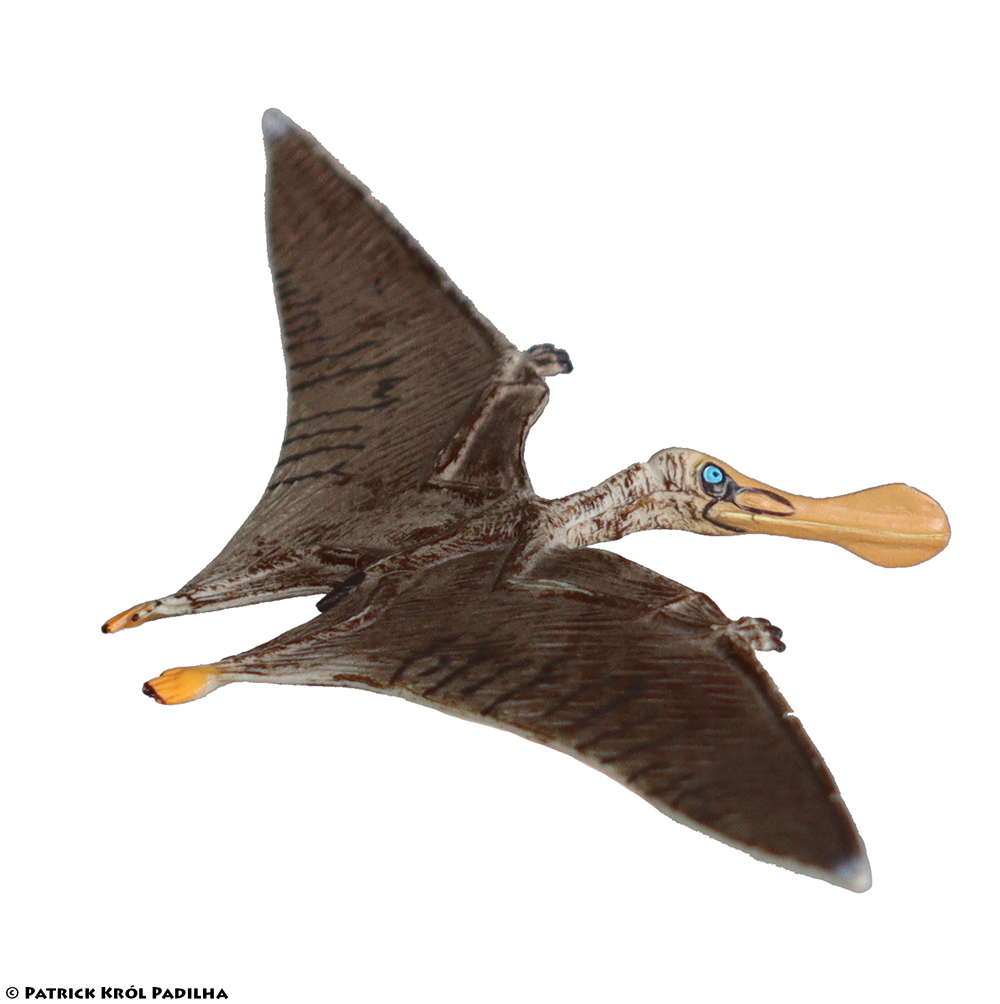
The story behind the piece is interesting, so before I dive into the details of the sculpt itself, allow me to share a bit more of its tale. It was designed by Toyway for the official WWD line, but was never released. Some rumors I heard was it got cancelled due to problems in manufacturing, since it was a thin figure from top to bottom, prone to bending and deforming. It was also a very wide one due to the wingspan, so it was hard to both make and package it in the normal WWD style blisters. I myself particularly doubt that, but felt I had to include it here.
It was supposed to be part of a new wave that would include other species from the series, which was cancelled, and to me the most likely reason for this was either due to poor sales of the line (which had limited distribution) or the end of the license agreement with BBC. Whatever the reason, what we actually know is that a handful of copies (test runs I suppose) of the Ornithocheirus were indeed made by Toyway and left unused, until the WWD official magazine published in the UK by Planet Three Publishing ran a giveaway to bestow some lucky readers with those rare copies of the pterosaur. Needless to say, this very limited giveaway is why it is one the rarest and most sought after prehistoric toys out there, at least if you are talking about plastic industrial-made figures.
As far as I know, only one copy of this model was given per magazine issue, and the magazine supposedly had only 16 or so issues before being cancelled too. They started giving the prize only after the third issue if my sources are correct, so a total of 13 or 14 copies of the Ornithocheirus should have been sent to readers. I was also told in the later issues, as the cancellation of the magazine approached, they started giving away about three copies of the Ornithocheirus per issue, but I so far have been able to verify that. I’m trying to guess here based on what I heard from other collectors, but I might be off by a few figures or totally wrong by a large margin, and for all I know somewhere in a dusty warehouse is a box full of these toys that never seen the light of the day. Another mystery of the figure is the packaging. I tried to find out if it came in a simple plastic bag or in the proper packaging blister like the others, but never found that answer either.
To this day, nobody in the dinosaur collector community seems to know the exact number of Ornithocheirus made, but we actually know of about six proven to exist in the hands of collectors, including my own. One of them, as far as I know, is with a collector from the US, four were in the possession of a collector in the UK, and the last one would be my own copy, down here in Brazil. Those are the only proven copies of the model know to exist now. Just for the sake of being thorough, I did read about someone buying one from eBay for about 800 dollars back in 2006 or so, but this information was not backed up by pictures of the figure, screenshots of the auction, or the name of the buyer, so it might be a myth. If not, that would be the seventh copy known, but until proof surfaces, I don’t really count it. If others have been found, I am not aware.
Being a huge fan of the BBC series and an avid “completist” collector, I had been hunting down this model for about 12 years or so, tirelessly browsing eBay day after day, before I manage to acquire one from a person in the UK. I didn’t have the luck to find it in a toy lot for cheap, but it seems most copies of the Ornithocheirus known were found exactly that way, usually by collectors that weren’t really looking for them. So if you want to find one, your best bet would be to constantly search eBay UK for it and try your luck inspecting random lots carefully. It is hard to calculate a price for such a rare item, for which there are not many precedent sales, but if sold in a properly described listing, it easily goes for over 500 dollars.
Anyway, enough rambling about the history of the toy, let’s actually talk about it. The figure was made to represent the giant Ornithocheirus seen in the “Giant of the Skies” episode. Although the series called it O. mesembrinus, the species was since renamed as Tropeognathus mesembrinus, which is so far the largest known pterosaur from Brazil, with a wingspan estimate ranging from 6 to 8 meters.
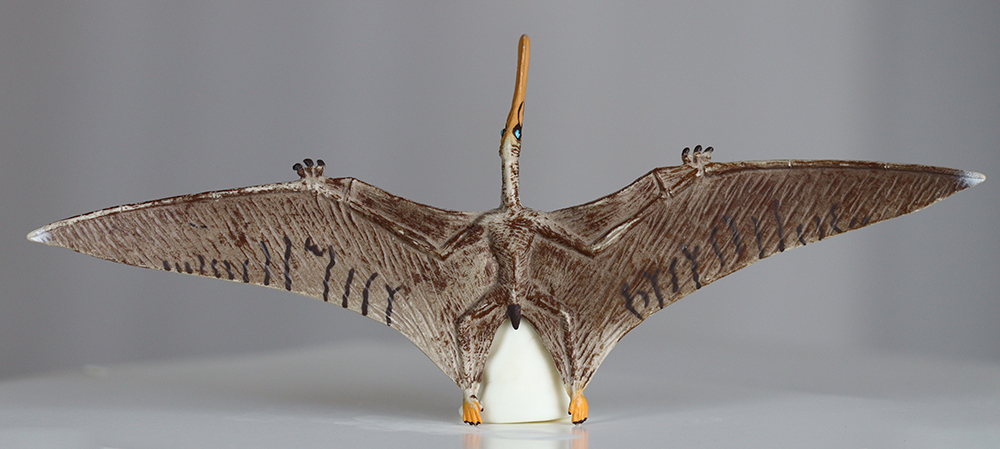
The toy, despite being simple, did a good job of depicting the animal from WWD in plastic. It is sculpted in a traditional flight pose, with the wings fully outstretched, the legs held straight behind the body, and the head also held straight out and with the beak slightly tilted downwards. Poses, one might say, were the main flaw of the Toyway WWD figures because they were done reusing the CGI models from the documentary, resulting in really faithful reconstructions, but bland and static neutral poses.
The Ornithocheirus was made from the same plastic as the rest of the line, a somewhat hard material that is of good quality. The figure, if held by a single wing, won’t deform and bend under its own weight, but the wings can be bent a bit if you apply a bit of pressure, but they are still very stiff. The wingspan of the model is exactly 25 centimeters and the length of the body measures a total of 10.5 centimeters from the tips of the toes to the tip of the beak. As far as scale goes, I’m not the best at calculating it, but using the series size claim of a (outdated) 12 meters wingspan it would result in a 1:48 scale model. If we use the current maximum 8 meter wingspan for the species, we get a 1:32 scale figure.
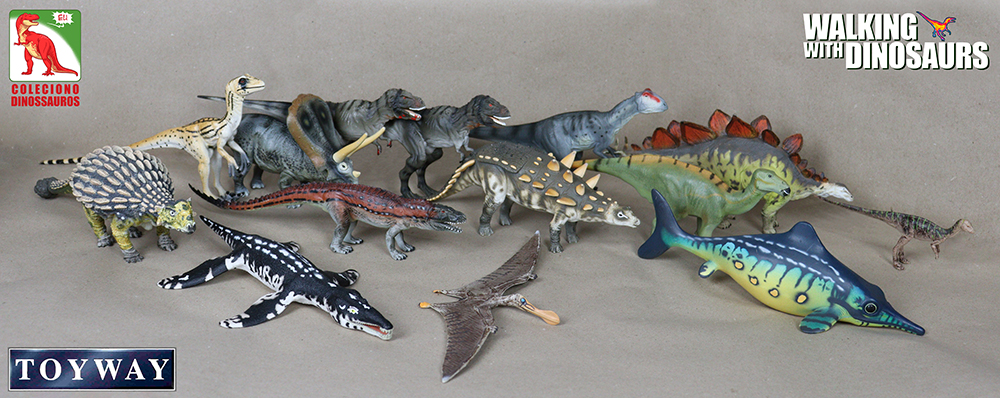
Analyzing the model and comparing it to the animal seen in the show, it is pretty similar, just like the rest of the line. The toy has the same color pattern, despite being a tad simplified for ease of paint application. A light gray undertone is the base color, which seems to be the color of the plastic. Next, there is an airbrushed brown misting over top, almost covering the entire gray base on the upper side of the figure, but less so on the underside of the wings, which are considerably lighter.
The dorsal region is finished with a heavy dry brush of brown, probably the same shade as before, which makes the texture of the figure pop out, as well as the contours of the wing bones. The wings are decorated with black irregular stripes in the posterior edge of the patagium, but only in the dorsal side. The undersides of the wings also have a bit of dry brushing, but less intense, leaving two spots on each wing with no dry brushing at all, only the pure base gray color. The very tips of the wings have a bit of white airbrushed on. The feet and beak are painted in a dark yellow that changes to almost orange in the feet, while the toe claws are represented by simple black dots. The head has a dark brown, almost black mask around the eyes, similar to the pattern of the model in the series, surrounding really vivid light blue eyes with black dots as the pupils. The mouth is a simple thin line of light yellow and the hand claws are painted dark brown.

Sculpting-wise it is quite nice, although simple by today’s standards. The body texture on both sides resembles more skin wrinkles than pycnofibers, but with a bit of good will, one could consider that as some sort of fur-like texture. The Ornithocheirus in WWD appeared to have some pycnofibers, closely seen when the blood-sucking parasite is shown infesting its skin, so the original model might have had some pycnofibers, but those filaments didn’t translate well in this scale. The wings also have texture made by simply carving parallel stripes in the membrane, all following the same orientation. They probably wanted to represent fold of skin and perhaps the skin fibers of the wings, but with this toy, it ended up being a very simple texture.
The feet lack any texture, as does the beak, which is almost smooth with no teeth in sight, unfortunately. I think the lack of teeth was also a design choice done to simplify the manufacturing process, since very thin, interlocking teeth would be a pain to mold properly. Near the eyes, you can see the nostrils, which were left unpainted. The mouth has some sort of mold flashing protruding out of the beak, which is hard to see, but seems to exist in all known copies, which might indicate that Toyway had planned to make it holding a fish or other prey in the mouth, but that was cancelled. Another possible explanation is that they decided to make the injection mold pour exactly in that spot, which is strange considering the head and face of a model are always a focal point and not the best place to leave a mold line or injection spot.
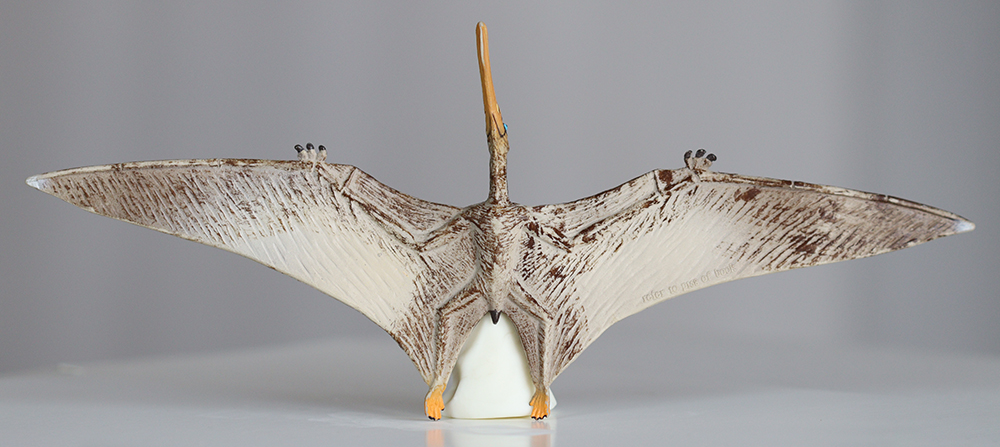
The Ornithocheirus‘ eyes bulge out and stand out well in the dark background. The neck has skin wrinkles, as do the arms, which also present muscle definition in some areas. Surprisingly, the model has a clearly visible pteroid bone, which to this day is often ignored in toy pterosaurs by manufacturers. Each hand correctly has three clearly identifiable fingers with claws, plus the fourth wing finger. The feet has five toes each, one of which is shorter, a trait that might be only partially correct because pterodactyloid pterosaurs lost or drastically reduced their fifth toe during their evolution. So back in 2000 when they made this design, it was done with a reduced toe, but many modern reconstructions of this genus show it with only four toes.
The figure correctly represents the narrow keels in the tip of the beak, with a larger keel on the upper jaw and a smaller one on the lower jaw, neither of which were not very well-textured nor painted in bolder red colors as they appeared in the show. The tail is very small, as it should be, fully painted in dark brown with little texture. The wings are almost accurate, just lacking one bone in the fingers, which have three phalanges instead of four. The patagium, the main wing membrane, is represented a bit larger than we usually see in more recent reconstructions, so that might be another outdated bit of this model.
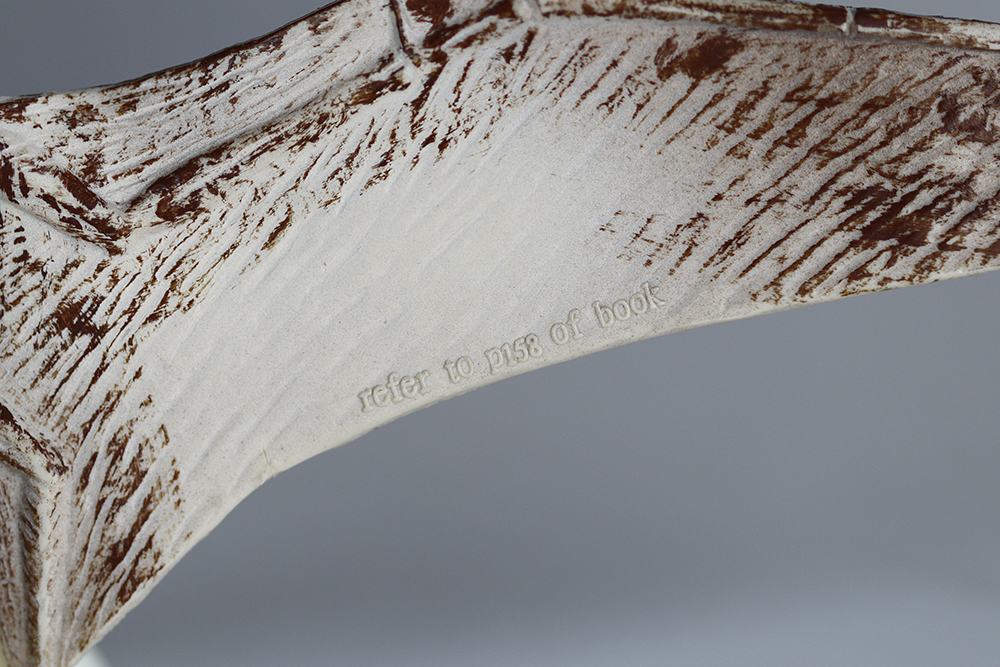
One unusual detail in this figure is the presence of a single text stamp in the underside of the wing, which says “refer to p. 158 of book.” This is a reference to the official Walking With Dinosaurs book, which talks about the Ornithocheirus on page 158. Ornithocheirus is the only WWD figure to have such text, the others having instead the name of the creature, copyright information and “Made in China” stamped on them. There’s basically no information why Toyway did this, or if it was something planned to be implemented in all figures from the new wave or not.
All in all, for a figure made in the early 2000s, this model is quite good, well-detailed and well-painted and is for sure an important icon of prehistoric animal figures. Even with all its apparent flaws, it stands to this day as a really cool model and a decent, if not perfect representation of a Tropeognathus. In the end, the main appeal of this figure is not its accuracy or level of detail, though, but rather that it is so desired and sought-after more for its nostalgic role, its history, and its rarity than anything else. Many collectors wish to one day complete their collections by adding this holy grail to their displays. To these collectors, all I have to say is: keep hunting, you never know when you might get lucky! I myself still can’t believe this Ornithocheirus made the reverse migration from UK to Brazil, to end up in my hands.
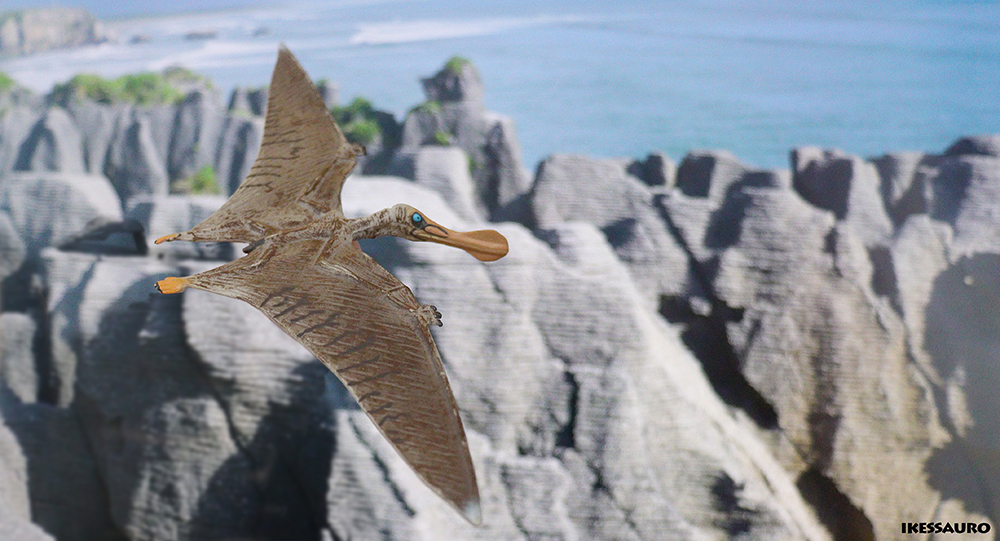
Disclaimer: links to Ebay and Amazon on the DinoToyBlog are affiliate links, so we make a small commission if you use them. Thanks for supporting us!



Great review of a very precious figure. Glad to see there’s one at least been able to cross the Atlantic to its homeland!
Thanks for clarifying Simon! I actually remember yours being the first and only one known for quite a few years. Also your luck of buying it for 12.50 was incredible. Did it come in a blister package like the others? I always wondered about the package of this toy
Yes. It was in a clear blister package with no card.
PS Thanks for your help in getting Ademar’s Argentinosaurus in 2013. Ademar and I are friends on FB now, and I am currently working on painting up his incredible Patagotitan.
What a remarkable story for such a modest (but still nice) figure! Thank you for this thorough review of a very special collectible.
The Holy Grail with a condign review!
It is a beautiful figure. Now to “set the record straight” about the first appearance of this figure on-line. ;>)
I purchased the first copy of this figure to appear on the Internet in 2006 on ebay.uk for $12.50, MIB. (Yeah, I know, I know. But no one else bid on it. I bid the auction ALL the way up to $75!!! *LOL*LOL*LOL*)
In 2014 when I downsized my collection I sold it for $700 to another US collector.
Since then several others were acquired in the UK by a single collector (as seen on the DTF).
CONGRATULATIONS to you on your acquisition as I know how much it means to a serious collector like you to complete your WWD dinosaur figure set! :>)
Fantastic review, very thorough. I never thought I would see this figure reviewed on the blog. Thank you for your contribution!
It’s an incredible figure. I too got some of the Magazines, but strangely enough, they did not come with these figures. Thank you for sharing.